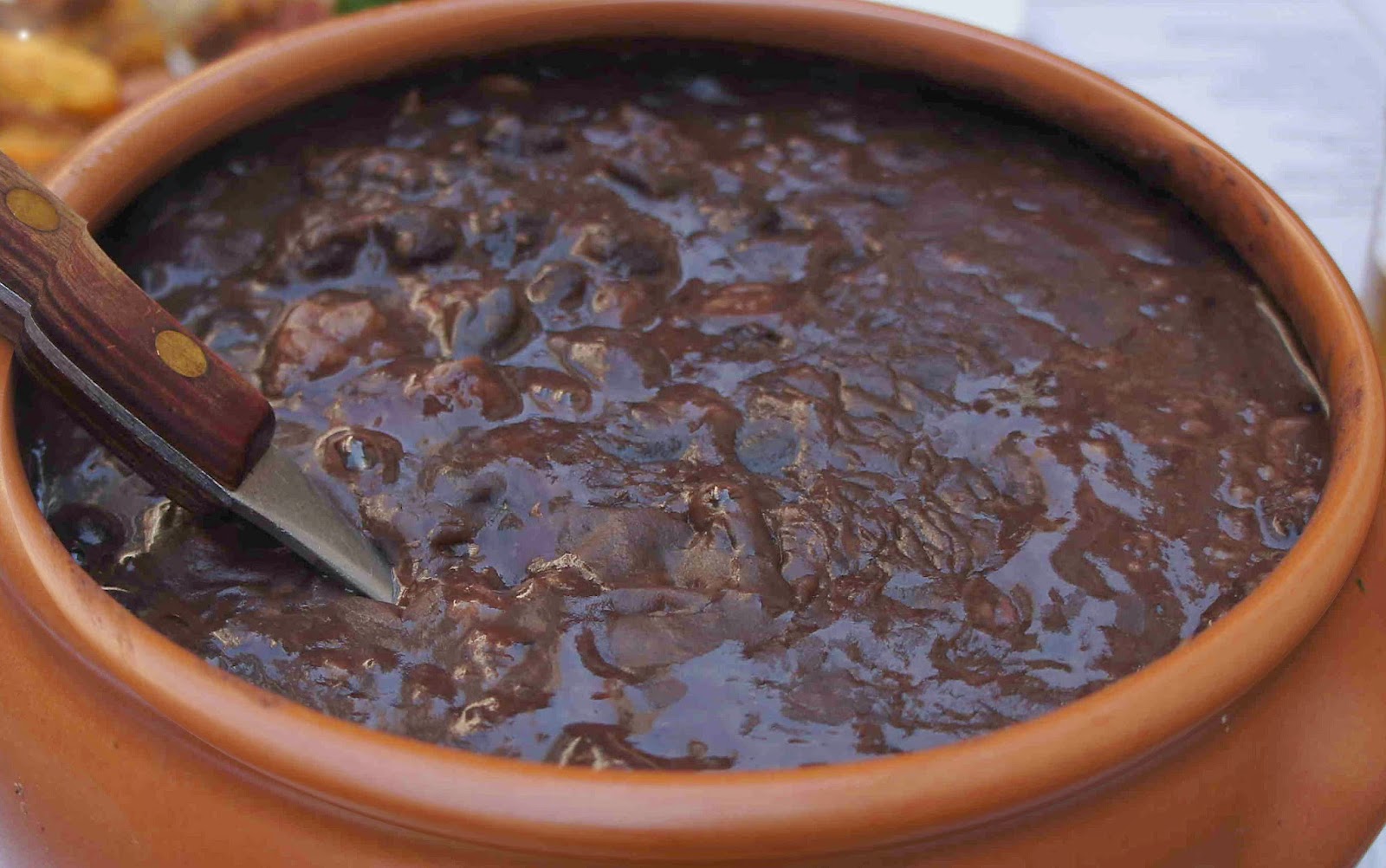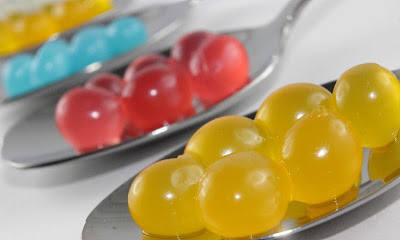What are Black Beans?
Black beans or black turtle bean is a small, shiny variety of common beans (Phaseolus vulgaris), especially popular in Latin American cuisine, though it can also be found in Cajun and Creole cuisines of south Louisiana. They are often called simply black beans (frijol negro, zaragoza, judía negra, poroto negro, caraota o habichuela negra in Spanish, and feijão preto in Portuguese), although this can cause confusion with other black beans.
Black beans are smaller than pintos, and, even when thoroughly cooked, have a firmer consistency. Depending on the tool you use to mash them, they can be a little harder to crush, partly because of their firmness, and partly because they're small. With the use potato masher, for instance, they tended to slip through its grooves, which meant you have to spend a bit more time working them into a paste. Black beans don't have the same sweet note that pintos do, but they still make delicious refried beans.
The black turtle bean has a dense, meaty texture, which makes it popular in vegetarian dishes, such as frijoles negros and the Mexican-American black bean burrito. It is a very popular bean in various regions of Brazil, and is used in the national dish, feijoada completa.
In Cuba, black bean soup is a traditional dish, usually served with white rice and it is also a main ingredient of Moros y Cristianos. It is a must-have in the typical gallo pinto of Costa Rica and Nicaragua, is a basic ingredient of pabellón criollo in Venezuela, and is served in almost all of Latin America, as well as many Hispanic enclaves in the United States. In the Dominican Republic dishes, it is also used for a variation of the Moros y Cristianos simply called Moro de Habichuelas Negras. The black turtle bean is also popular as a soup ingredient.
Black turtle beans were reported to contain total anthocyanins in their dried seed coats of 0-2.78 mg/g. Anthocyanins are good for your health, it acts as powerful antioxidants.
The seed coat of the black bean (the outermost part that we recognize as the bean's surface) is an outstanding source of three anthocyanin flavonoids: delphinidin, petunidin, and malvidin. Anthocyanins are water-soluble vacuolar pigments that may appear red, purple, or blue depending on the pH.
Preparation: 10 minutes
Cooking: 20 minutes
Yield : 4 to 6 Servings
INGREDIENTS:
1 teaspoon olive oil or canola oil
1 teaspoon ground cumin
2 garlic cloves, minced
3 cups cooked black beans (boiled for 1.5- 2 hours, use pressure cooker to shorten time. don't pre-soak the beans. READ the reasons below whichever you prefer soaking or not soaked beans).
1- 1/2 cups diced fresh or canned tomatoes
Salt
Freshly ground black pepper
COOKING PROCEDURE:
1) Heat the oil in a medium skillet or saucepan.
2) Add the cumin and garlic and saute for about 2 minutes, until the oil smells fragrant.
3) Add the beans and tomatoes and cook until heated through. Let the beans come to a brisk simmer, then lower the heat to maintain a gentle simmer. Cook and stir from time to time for 15 to 20 minutes.
4) Using a potato masher, mash the beans.
5) Then stir with a wooden spoon to make a fairly smooth mixture.
6) Season to taste with salt and pepper and serve warm.
A Few Fast Serving Ideas
a) You can blend cooked black beans with tomatoes, onions and your favorite spices to create a delicious bean soup.
b) Black bean soup or chili is certain to warm you up on cold snowy winter days or anytime of the year you want to enjoy its nurturing essence.
c) In a serving bowl, layer black beans, guacamole, chopped tomatoes, diced onions and cilantro to make a delicious layered dip.
d) For a twist on traditional burritos, use black beans in place of refried pinto beans.
Quick Cooking Tips:
1) If you’re cooking the beans from scratch, start with 1 1/2 cups dry beans and reserve 1 cup of the cooking liquid to use instead of the stock. Add a little water or stock to the beans when you rewarm them.
2) You can keep the cooked black beans in the fridge for up to five days.
3) Before washing black beans, spread them out on a light colored plate or cooking surface to check for, and remove, small stones, debris or damaged beans. After this process, place the beans in a strainer, rinsing them thoroughly under cool running water.
Related Post: How to Cook Beans or Legumes
Best Reasons for Soaking the Black Beans
The soaking of black beans in water has always found widespread support in food science research as a way of improving overall black bean benefits.
(1) Soaking your black beans overnight will greatly reduce enzyme inhibitors and phytic acid, making them easier to digest means less flatulence (presoaking has been found to reduce raffinose- and stachyose-type oligosaccharides, sugars associated with causing flatulence). Just be sure to use fresh water for cooking. Even if you can only soak them for a few hours, it helps. Soaking beans for around 18 hours can reduce phytic acid by 50 to 70 percent.
(2) Soaking your beans first will also reduce cooking time by 45 percent.
There are two basic methods for presoaking. For each you should start by placing the beans in a saucepan and adding two to three cups of water per cup of beans.
a) The first method is to boil the beans for two minutes, take the pan off the heat, cover and allow to stand for two hours.
b) The alternative method is to simply soak the beans in water for eight hours or overnight and place the container in the refrigerator to prevent beans fermentation.
Before cooking the beans, regardless of method, drain the soaking liquid and rinse the beans with clean water.
Do I Need to Dispose the Soaking Water?
The discarding of the bean soaking water has been a topic of considerable controversy on food blogs and other type of websites. Some websites and bloggers have argued that this soaking water contains too many valuable nutrients to discard. However, a recent scientific study that may help put this debate to rest by comparing a wide range of factors involved with the content of the soaking water. It looked at many different advantages and disadvantages of disposing the water used to soak beans. It found that the advantages clearly outweigh the disadvantages.
Advantages of discarding the soaking water
1) Food science research analysis has shown that discarding the soaking water also means getting rid of some of the phytates and tannins that can lower nutrient availability. Phytates, specifically phytic acid, have been shown to block the mineral absorption of calcium, magnesium, iron, and zinc in humans.
2) It also means reducing flatulence-related substances like raffinose (up to 33% removed along with the soaking water) and stachyose (up to 20% removed).
3) A final advantage was the retention of resistant starch. While some of the total carbohydrate content in the black beans was lost along with the discarding of the soaking water, the amount of resistant starch remained unchanged.
Resistant starch is a type of carbohydrates that will typically make its way all the way down to the large intestine without being digested. Once it arrives in the large intestine, it can help support the growth of desirable bacteria in that area of the digestive tract.
Disadvantages of discarding the soaking water
1) Disposing the water will result in an unwanted loss of total phenols, but the extent of that loss will be relatively small (about 15%). While some of the total carbohydrate content in the black beans will be lost along with the discarded soaking water, the amount of digestion-enhancing resistant starch will remain unchanged.
2) There was a slight loss of some additional phytonutrients as well as minerals. When adding up all of their findings, the food science researchers concluded that the many advantages of discarding bean soaking water clearly outweighed the disadvantages and then made this recommendation a firm part of their research conclusions.
Reasons for Not Soaking the Beans
(1) According to some cooks and amateur food bloggers, not-soaked black beans taste better than soaked beans. Soak black beans don't have a strong bean flavor.
(2) If you use pressure cooker it cook almost as quickly as the soaked black beans.
(3) I had great texture compared to the soaked black beans.
If you enjoyed this healthy dish, your family will surely enjoy this one... Acarajé- Black-Eyed Pea Fritters- Brazilian Food Recipes
CALORIE COUNTER: Homemade Refried Black Beans Recipe (Frijoles negros refritos)
Refried black beans is very low in Saturated Fat, Cholesterol and Sodium. It is also a good source of Protein, Thiamin, Magnesium, Phosphorus and Manganese, and a very good source of Dietary Fiber and Folate.
Nutrition Facts
Serving Size 1 cup (252 g)
|
Per
Serving
|
%
Daily Value
|
|
Calories
|
237
|
|
Calories from Fat
|
29
|
|
Total Fat 3.2g
|
5%
|
|
Saturated Fat 1.2g
|
6%
|
|
Polyunsaturated Fat 0.4g
|
|
|
Monounsaturated Fat 1.4g
|
|
|
Cholesterol 5mg
|
1%
|
|
Sodium 75mg
|
3%
|
|
Potassium 672.84mg
|
19%
|
|
Carbohydrates 39.1g
|
13%
|
|
Dietary
Fiber 13.4g
|
53%
|
|
Sugars 0.6g
|
|
|
Protein 13.8g
|
|
|
Thiamin
|
25 %
|
|
Folate
|
20 %
|
|
Vitamin A
|
0%
|
|
Vitamin C
|
25%
|
|
Calcium
|
9%
|
|
Iron
|
23%
|
|
Phosphorus
|
8%
|
|
Manganese
|
10%
|
|
Magnesium
|
13%
|
Did you know?... Broccoli Benefits: Super Food Broccoli- Brassica oleracea Italica
References:
Kadam, S. S.; Salunkhe, D. K.; Chavan, J. K. 1990. Dietary tannins: consequences and remedies. Boca Raton: CRC Press. ISBN 0-8493-6811-1
Lappe, Frances Moore. 1981. Diet for a Small Planet. Ballantine Books. ISBN-10: 0345321200
McGee, Harold. 2004. On food and cooking: the science and lore of the kitchen. New York: Scribner. ISBN 0-684-80001-2
Wolke, Robert L.; Marlene Parrish. 2005. What Einstein Told His Cook 2: the sequel: further adventures in kitchen science. W. W. Norton & Company. ISBN 978-0-393-05869-7



No comments:
Post a Comment